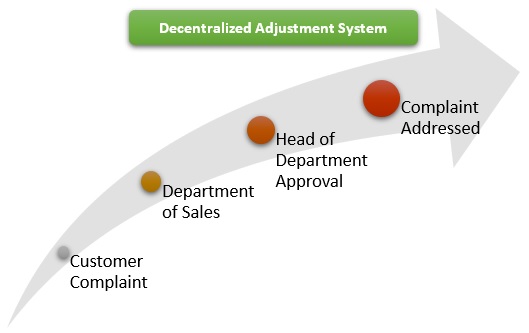- Business Concepts ›
- Marketing and Strategy ›
- Decentralized Adjustment System
Decentralized Adjustment System
Definition, Importance & Example
This article covers meaning & overview of Decentralized Adjustment System from marketing perspective.
What is meant by Decentralized Adjustment System?
Decentralized adjustment system is a business system where consumers escalate their grievances straight to the sales division. In decentralized adjustment system, customers don’t really go through the customer service desk, or a customer service agency, but directly approach the sellers responsible. A decentralized adjustment system can lead to betterment and strengthening of relations with existing customers and newer customers.
The sales division make most of the adjustments to get cleared with the complaint but any greater level of change in terms of adjustments has to receive the final approval of the head of the department or the supervisor of sales mandatorily. Customer grievances being addressed by the seller directly removes layers of contact persons a customer has to go through to get a problem solved. This may sometimes lead to the customer falling through in the middle of the process. Instead a decentralized adjustment system leads to quicker solving of customer complaints.
Importance Decentralized Adjustment System
The primary importance of decentralized adjustment system is that the customer’s complaint doesn’t go unaddressed. This channel allows the complaint to be directly addressed by the sales department, to understand the nitty gritty ties of the customer’s situation much better. We see that some complaints go unheard if they go through a lot of layers or processing, whatsoever be their magnitude.

The problem gets solved more quickly and easily in decentralized adjustment system if the problem reaches the solvers directly. In this system the multiple parties involved like the customer or sales department are independent in terms of taking decisions. There is no obligation involved from either end or a contract since this is a decentralized system. The agents here also have the ability to operate locally. It is very essential in customer retention. If customer complaints are addressed are solved quickly, it leads to increased brand image and recognition.
Example of Decentralized Adjustment System
1. As an example, we can take the situation of HP laptop owners. We see that not all owners go through the store from where they have purchased or the customer services online or on phone. They prefer going to the service centres directly. This makes it a decentralized adjustment system which has been successfully established to address all forms of customer complaints be they of any magnitude.
2. Let’s take another example of clothing accessory. Suppose a customer buys a Zara top from Pantaloons, and he or she has a problem with it. He or she may directly address it to Pantaloons (the seller), and not go through Zara and its different layers of customer service or its service agents online or the Zara exclusive store itself. This is a classic example of a decentralized adjustment system that has been automatically formed because Zara decided to sell its clothing accessory through Pantaloons. In this way if there’s any issue with the product Pantaloons can directly handle it because the frequency of Pantaloon stores is much higher than Zara stores in the whole city concerned. This makes it easier for the customer to get its complaint addressed and also leads to increased customer retention.
Hence, this concludes the definition of Decentralized Adjustment System along with its overview.
This article has been researched & authored by the Business Concepts Team which comprises of MBA students, management professionals, and industry experts. It has been reviewed & published by the MBA Skool Team. The content on MBA Skool has been created for educational & academic purpose only.
Browse the definition and meaning of more similar terms. The Management Dictionary covers over 1800 business concepts from 5 categories.
Continue Reading:
What is MBA Skool?About Us
MBA Skool is a Knowledge Resource for Management Students, Aspirants & Professionals.
Business Courses
Quizzes & Skills
Quizzes test your expertise in business and Skill tests evaluate your management traits
Related Content
All Business Sections
Write for Us